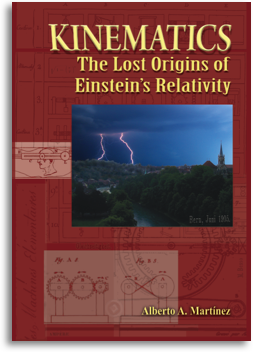












Reply to Suman Seth
A response to Suman Seth’s review of
Kinematics: The Lost Origins of Einstein’s Relativity,
in the journal Historical Studies in the Natural Sciences, vol. 41, no. 1 (Winter 2011), pp. 112-122.
Alberto A. Martínez
In Historical Studies in the Natural Sciences, Suman Seth comments on my book Kinematics, while discussing also books by Kristian Camilleri, Richard Staley, and Matthew Stanley. The essay review is titled “The History of Physics after the Cultural Turn,” and accordingly Seth focuses on recent discursive approaches in history, including historians’ efforts to reconstruct experimental practices and to contextualize the lives and works of physicists in regard to social, religious, and political factors.
Seth describes my book as “a classic history of ideas” because it does not exhibit anthropological dimensions such as how experimentalists carried out their practices, how scientists constructed mythical histories of their field, and how religious and sociopolitical factors interacted with science. I appreciate such dimensions of science studies, so I feel compelled to reply as to why my book does not much involve them: mainly, because kinematics developed as a minor and neglected branch of physics which involved hardly any experiments, was developed by individuals who analyzed motion in a self-consciously anti-metaphysical vein (lacking religious connotations), and that these individuals were often eccentrics whose incursions into kinematics were not motivated by socio-political factors.
Next, Seth complains that “in several chapters, the author fails almost entirely to situate his work within the secondary literature on the topic at hand. A chapter on nineteenth-century critiques of the foundations of mechanics, for example, mentions neither the considerable literature on the ‘crisis’ of the mechanical worldview, nor more specific secondary works on figures such as Ernst Mach or Henri Poincaré.” I reject Seth’s critical claim because there was no “failure” involved: throughout the book I mostly did not include references to the secondary literature of topics because I chose instead to focus on primary sources. My editor at Johns Hopkins University Press, Robert Brugger, also insisted that I should not discuss secondary literature because it soon makes books dated. I agreed only inasmuch as I preferred to discuss the past itself rather than at length praise and critique writers’ various characterizations of it. Considering that the book is 477 pages in length and covers topics from Greek antiquity, through the Renaissance and the Enlightenment, to the early 1900s, I can think of no other example in the history of modern physics, that uses such an extensive range of primary sources, in English, French, German, Latin, Spanish, Japanese.
I certainly would appreciate a critique if any of the secondary works that Seth is thinking about happen to correct anything that I wrote. But consider his specific allusion to Mach, for example. Whereas many writers still refer to Mach as “a philosopher” I properly characterize him as a physicist who had strong interests in psychology, and I trace his labors within a tradition of thinkers that includes Kant, von Herder, Beneke, Ampère, Fechner, Neumann, Dühring, Calinon, Lange, Stallo, Streintz, Browne, Thomson, Lechalas, Appell, and others. Most of these names are not even found in any one book on the origins of Einstein’s relativity, for example, Arthur I. Miller’s classic study, Albert Einstein’s Special Theory of Relativity, or Olivier Darrigol’s extraordinary work, Electrodynamics from Ampère to Einstein. A few other writers, to be sure, had separately treated briefly or at length, some individuals’ works in the tradition that I outline, yet my account is not derivative inasmuch as I did not rely on secondary sources but instead used primary sources to an unusual degree.
Regardless, Seth “calls into question the validity of the title of a book ostensibly on the ‘lost origins of Einstein’s relativity.’ Insofar as sources were unfamiliar, they do not seem to have been ‘originary’ for Einstein’s work; insofar as they were resources for Einstein’s thinking (Mach, Poincaré, and so on), one can hardly refer to them as ‘lost.’” To this complaint I give two replies. First, very often, titles of books are not set by authors but by publishers, as in the present case. Second, the title, Kinematics: The Lost Origins of Einstein’s Relativity, is nevertheless appropriate because it refers to how Einstein’s work was rooted in the history of kinematics, an important field that has been thoroughly neglected by historians of relativity in particular, and historians of science in general. For over a century, thousands of physicists, philosophers, and historians have almost unanimously acknowledged that what crucially distinguished Einstein’s original approach to electrodynamics, from those of H.A. Lorentz and others, was that Einstein defined a new kinematical basis for physics. Yet no book or article had systematically researched the history of physical kinematics leading to the kinematic roots of Einstein’s relativity. I do not know if this seems sufficiently original to Seth, but it certainly felt original to me during the years in which I worked on this project. A small point in the title is the word “Origins,” it matters because it is plural, insinuating that Einstein’s special relativity had many roots: in electrodynamics, in optics, in kinematics, in philosophy, etc. My book just focuses on kinematics.
Now, when writers publish provocative new books: arguing that Einstein was influenced by cultural factors, such as by art, or by Swiss patent applications, or by his wife, or by a mystical belief in God, etc., they often fail to resist the urge to portray that topic, that alleged factor, as if it had been the most important factor in the emergence of relativity theory. Therefore, one of my narrative strategies in Kinematics was to reconstruct the varied and branching history of kinematics in a way that would not give the illusion that kinematics was the most important factor. Thus, for example, in my chapter on “Discovery and Invention,” readers will see that even the word ‘kinematics’ is absent in many pages, and I noted, for example, that “It was thanks to the labors of Lorentz, above all, that Einstein and many other physicists were able to pursue electrodynamics along definite lines.” Moreover, another narrative aim was to ensure that I did not create the misleading illusion of a linear history. Instead, as I demonstrated at length, the kinematics initiated by Ampère in 1834 had various roots in the ancient and recent history, and once clearly defined, it nonetheless promptly splintered into various branches: such as the kinematics of mechanisms, and, an allegedly “a priori” mathematical kinematics, and, physical kinematics based on perceptions, and so forth.
In any case, since Seth raises the issue of how my work relates to cultural history of science, I might as well say a few words about this. If we look only at one topic: the years 1895 to 1905 in the life of young Albert Einstein (which is the topic of my Chapter 6), we could ask many interesting and suggestive cultural questions. For example:
* Given Einstein’s identity as an entirely irreligious German-born Jew, living in Switzerland and having renounced his German citizenship, how is it that such factors might have contributed to his works in physics?
* Given Einstein’s job at the patent office in Switzerland, where precision clocks were matter of cultural pride, how is it that such a role might have influenced him in formulating the relativity of time?
* Given the relations between women and men in Switzerland in from 1895 to 1905, how is it that such relations might have affected the potential professional development of Mileva Marić and Albert Einstein in science?
* Given the innovative developments in art and aesthetics in Europe at around 1900, the rise of abstraction and impressionism, leading to cubism and expressionism, how is it that the cultural factors that led to such movements might have also influenced the rise of the theory of relativity?
These are all interesting questions, yet my book did not propose any hypotheses to try to answer any of them. Instead, I avoided topics for which there is little evidence, topics which, like these questions, depend essentially on the speculation “might have.” Instead, I carefully answered questions such as the following:
* What specific documentary and retrospective evidence is there about how Einstein formulated his special theory of relativity?
* What specific evidence is there that shows the distinct ways in which Einstein’s studies of Kant, Schopenhauer, Mach, and Hume affected his intellectual development?
* What specific evidence is there of how Albert Einstein’s relationship with his girlfriend and wife, Mileva Marić, contributed to his labors in physics?
* What specific evidence is there of how Einstein’s relationships with friends and professors contributed to his intellectual development and his eventual formulation of relativity theory?
* What specific evidence is there of how Einstein was impressed and influenced by particular physical experiments?
* What specific evidence is there about how Einstein’s job at the Swiss patent office contributed to his development and his work on relativity?
* What specific evidence is there of how concepts in the history of kinematics contributed to Einstein’s formulation of a new kinematic basis of physics?
I do not expect that these latter questions, and others like them, will be as attractive to all readers as the speculative questions listed previously. The speculative questions are more interesting to many people because they invite us to make conjectures to interconnect major historical elements such as relativity, sexism, God, nationalism, modern art, etc. But they are also problematic inasmuch as they often proceed by guesswork and invention, rather than by evidence. Accordingly, in the case of the history of special relativity, I can point to various books and articles that describe “historical” events that are really fiction.
Music, as a further example, is a cultural product and I did not say much about it in my book, just as I did not discuss religions or politics, so hence Kinematics overall, certainly cannot be described as cultural history. Nonetheless, the book discusses various topics that are cultural. It discusses how philosophers and physicists gradually overcame ancient biases against physical labor and the study of mechanisms. It discusses how civil, military and educational factors in the French Revolution, post-revolutionary Paris and the École Polytechnique led to the rise of kinematics. It discusses how developments in psychology, anti-metaphysical philosophy, and critical history led to the rise of critiques of the foundations of physics. It traces how several engineers contributed to that process. I agree with Suman Seth when he does not classify my book as cultural history, nor even as what he calls a “new intellectual history.” But nevertheless, there are other merits in Kinematics and I hope that it will be helpful and useful to readers interested in the history of physics.


